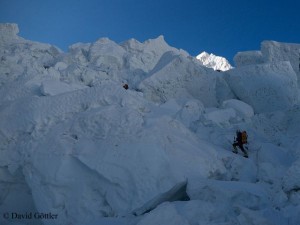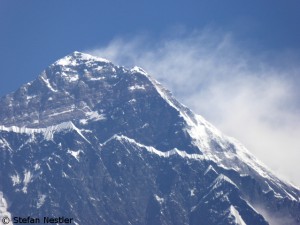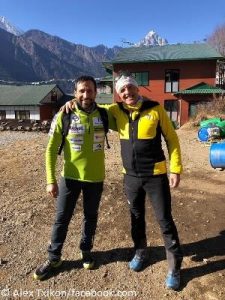Dujmovits: “Go to the north side of Everest!”
The good weather window on Mount Everest has not yet opened. “Heavy snow in Everest Base Camp at the moment,” American Dan Mazur, expedition leader of the operator Summit Climb, today wrote on Twitter from the Nepalese south side of the mountain. “Our Sherpas are working high up on the mountain, carrying oxygen, ropes, tents, food.” On the north side of Everest, the Americans Adrian Ballinger and Cory Richards climbed today to an altitude of about 7,600 meters. “For just today, I’m pretty sure Cory and I were the highest people on the planet”, Adrian wrote on Instagram. “Does it matter? Of course not. But it felt special.” The two climbers, who want to scale Everest without bottled oxygen, returned to the North Col, “as afternoon clouds try to cross the border from Nepal into Tibet”. The weathermen expect for the next few days more snowfall on Everest. Maybe one or the other climbers in the base camps on the north and south side will use the time to read again Jon Krakauer’s book “Into Thin Air”. It describes the disaster on Everest in spring 1996. The 20th anniversary will be next Tuesday .
I have talked to Ralf Dujmovits about Mount Everest then and now. The 54-year-old is the first and so far only German who stood on the summits of all 14 eight-thousanders.
Ralf, you have taken an Everest sabbatical this year. Did you – like many others – want to see how the whole situation on Everest is developing?
I did not want to wait and see. I just had to take an one-year-break, otherwise the whole thing would have turned into work. I was now seven times on Everest. Six times I tried to wipe out the stain of 1992 when I had used bottled oxygen in the summit area. Sometimes you have to take a break and see something else. I’m looking forward to the summer in Pakistan. (Ralf and his partner, Canadian Nancy Hansen, will try to scale a still unclimbed seven-thousander.)
Two consecutive years without summit successes on the south side, in addition two avalanche incidents with a total of 35 dead – do you think the current spring season will be crucial for the future of climbing the highest mountain on earth?
I think it’s not necessarily representative what happens on Everest this spring. Nevertheless, I see the advantage for those who are now on the south side that there are far less climbers. Thus the danger of traffic jams on the route is lower. Apart from that, I believe that some operators have realized that the south side is very dangerous. That cannot be changed only by taking a new route through the Khumbu Icefall. Of course, as a “Goodwill Ambassador” I should promote Nepal. I really like to do it. But in case of Everest I tell people very clearly: Go to the Tibetan north side!
Do you think that this will be the only change in Everest climbing?
I think the gap regarding price, organization and safety is widening right now. On the one hand we have very cheap options of the Nepalese operators who are able to acquire many clients, partly with dumping prices, on the other hand the established operators who have very high safety standards and charge higher prices. I believe, in the future clients want to have customized offers based on their personal needs. In this field, the Nepalese operators are clearly more active. They tell their clients: If you want to, you can book only one or another service, for example only food for Base Camp. I believe, the western operators still have to learn this, to say: We want to continue our high safety standards, but we will enable the clients to climb the mountain in a manner other than the traditional way, completely being led up the mountain, the full program.
Key word: Safety. Next Tuesday marks the 20th anniversary of the 1996 incident on Everest, when within 24 hours eight climbers lost their lives during a storm in the summit area. Is it possible to compare that time with today?
So many things have changed. The leading operator then was Rob Hall with Adventure Consultants. (The New Zealander was among the victims.) The standard in 1996 was relatively high for that time. But very reliable weather forecasts were still missing. With today’s quite reliable weather reports it should not happen any more that climbers run half unknowingly into bad weather. However, new problems have occurred due to the massification since 1996. At that time, there were three, four or five expeditions per season, today there are dozens. This has more likely changed to disadvantage and can be to the detriment of the guests.
Thus new disasters on Everest can not be excluded?
There will still be accidents – also because the global warming doesn’t stop at Everest. It is likely that big ice avalanches will continue to sweep down into the Khumbu Icefall from the Everest West Shoulder on the left or from Nuptse on the right. Thus the icefall remains dangerous. Previously the danger mainly resulted from the large movement of the ice. Seracs collapsed, crevasses opened, climbers fell into the depths because ladders were torn apart. This risk has remained at the same level, but the strongly increasing warming will provide additional risk potential.
On the north side too?
There the risk of ice debris is by far not as high as on the south side.
Let’s return to your Everest plans. This year, you stay well clear of the highest mountain on earth. But this doesn’t mean that you have completed this chapter, right?
First I will travel along with Nancy to Pakistan this summer. But in 2017, we are determined to return again to the north side of Everest. Most likely we will try to climb via the Messner traverse (solo climb in 1980) into the Norton Couloir.










